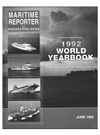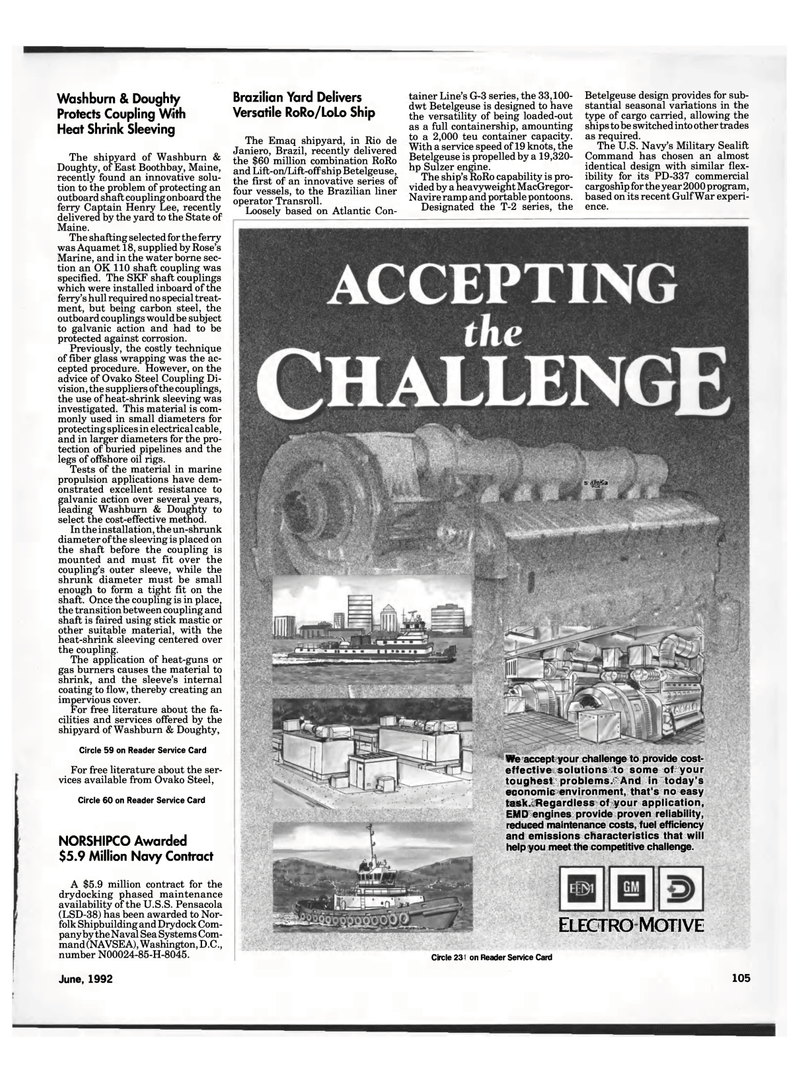
Page 95: of Maritime Reporter Magazine (June 1992)
Read this page in Pdf, Flash or Html5 edition of June 1992 Maritime Reporter Magazine
Washburn & Doughty
Protects Coupling With
Heat Shrink Sleeving
The shipyard of Washburn &
Doughty, of East Boothbay, Maine, recently found an innovative solu- tion to the problem of protecting an outboard shaft coupling onboard the ferry Captain Henry Lee, recently delivered by the yard to the State of
Maine.
The shafting selected for the ferry was Aquamet 18, supplied by Rose's
Marine, and in the water borne sec- tion an OK 110 shaft coupling was specified. The SKF shaft couplings which were installed inboard of the ferry's hull required no special treat- ment, but being carbon steel, the outboard couplings would be subject to galvanic action and had to be protected against corrosion.
Previously, the costly technique of fiber glass wrapping was the ac- cepted procedure. However, on the advice of Ovako Steel Coupling Di- vision, the suppliers of the couplings, the use of heat-shrink sleeving was investigated. This material is com- monly used in small diameters for protecting splices in electrical cable, and in larger diameters for the pro- tection of buried pipelines and the legs of offshore oil rigs.
Tests of the material in marine propulsion applications have dem- onstrated excellent resistance to galvanic action over several years, leading Washburn & Doughty to select the cost-effective method.
In the installation, the un-shrunk diameter of the sleeving is placed on the shaft before the coupling is mounted and must fit over the coupling's outer sleeve, while the shrunk diameter must be small enough to form a tight fit on the shaft. Once the coupling is in place, the transition between coupling and shaft is faired using stick mastic or other suitable material, with the heat-shrink sleeving centered over the coupling.
The application of heat-guns or gas burners causes the material to shrink, and the sleeve's internal coating to flow, thereby creating an impervious cover.
For free literature about the fa- cilities and services offered by the shipyard of Washburn & Doughty,
Circle 59 on Reader Service Card
For free literature about the ser- vices available from Ovako Steel,
Circle 60 on Reader Service Card
NORSHIPCO Awarded $5.9 Million Navy Contract
A $5.9 million contract for the drydocking phased maintenance availability of the U.S.S. Pensacola (LSD-38) has been awarded to Nor- folk Shipbuilding and Drydock Com- pany by the Naval Sea Systems Com- mand (NAVSEA), Washington, D.C., number N00024-85-H-8045.
Brazilian Yard Delivers
Versatile R0R0/L0L0 Ship
The Emaq shipyard, in Rio de
Janiero, Brazil, recently delivered the $60 million combination RoRo and Lift-on/Lift-off ship Betelgeuse, the first of an innovative series of four vessels, to the Brazilian liner operator Transroll.
Loosely based on Atlantic Con- tainer Line's G-3 series, the 33,100- dwt Betelgeuse is designed to have the versatility of being loaded-out as a full containership, amounting to a 2,000 teu container capacity.
With a service speed of 19 knots, the
Betelgeuse is propelled by a 19,320- hp Sulzer engine.
The ship's RoRo capability is pro- vided by a heavyweight MacGregor-
Navire ramp and portable pontoons.
Designated the T-2 series, the
Betelgeuse design provides for sub- stantial seasonal variations in the type of cargo carried, allowing the ships to be switched into other trades as required.
The U.S. Navy's Military Sealift
Command has chosen an almost identical design with similar flex- ibility for its PD-337 commercial cargoship for the year 2000 program, based on its recent Gulf War experi- ence. >••; jgi*
We accept your challenge to provide cost- effective solutions to some of your toughest problems. And in today's economic environment, that's no easy task. Regardless of your application,
EMD engines provide proven reliability, reduced maintenance costs, fuel efficiency and emissions characteristics that will help you meet the competitive challenge.
ELECTROMOTIVE
Circle 237 on Reader Service Card
June, 1992 105

 94
94

 96
96
